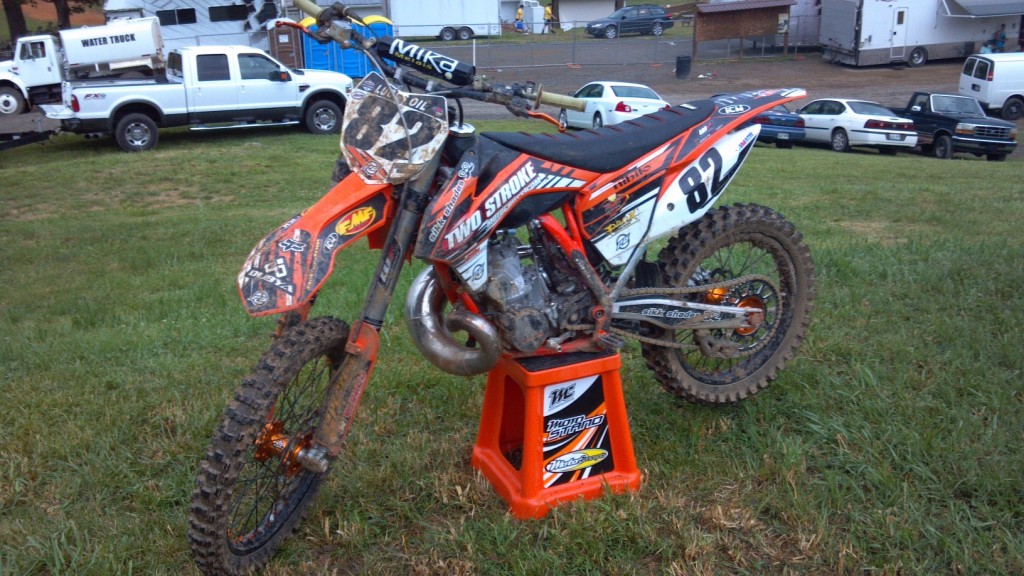It was a tough weekend for the Two Stroke Motocross – Sikk Shades team at the Muddy Creek National. The first round came up on us quick, some back ordered parts, shipping delays and a few other issues made it come down the last-minute. Smith and Sottile weren’t comfortable with limited time on the bikes, so they did not race. Sottile did run his 450, but did not qualify due to mechanical failure.
I was asked by “The General” to write a long-term test for the Maico 500. I own a 2004 Maico 500 and my brother owns a 2003 Maico 500, so I have a good idea of these bikes and a very good feel for them. I’ll do my best to give as many details possible.
The test report will be broken into three parts. The first part will deal with the bike itself. This will include everything from ergos, assembly and construction, the various things that make the Maico a Maico. Part two will be an in-depth look at the mechanics of these bikes. I have been through every part of these bikes and I’ll tell you everything I’ve found. In part three, I will cover of the most important part of the entire article. I will report what it is like to ride the Maico.
 My goal is to inform you, not to convince you that you need a Maico. Just for the record, a Maico is not for everyone. For those who wish to ride an open class two stroke, with European handling, then it’s worth your time to investigate the Maico.
My goal is to inform you, not to convince you that you need a Maico. Just for the record, a Maico is not for everyone. For those who wish to ride an open class two stroke, with European handling, then it’s worth your time to investigate the Maico.
The first thing that you will notice when you see the Maico in person is how tall it is. The Maico has one of the tallest seat heights in all of the industry. You’ll also notice that the Maico has a steel frame (I’ll cover my thoughts on this later). As you look over the bike, you will notice that everything is the grandest in size. The cylinder itself dwarfs that of a 250 two stroke. A friend once commented that the cylinder looks like something from “Sputnik”. It has a right side chain drive, and a left side kick.
You’ll also notice that Maico uses a linkage rear suspension. I will cover the suspension in more detail later. Maico uses a compression release for ease of starting. It is worth noting two simple things, it’s nearly impossible to start one of these bikes without the compression release. And that the compression release is not your dad’s compression release available in the 1960s and 1970s. The bike will start and run with the compression release pulled. It will not slow you down going downhill. The compressor release has one purpose and one purpose alone… to start the motorcycle.
The Maico is set up with a left side shift, right side brake. While the Maico has a premium price, it does come with quality components. Magura hydraulic clutch, Brembo brakes, HGS exhaust, and a PVL ignition are all standard on the MX models. My bike came with Akront rims and Maico hubs, but some are getting D.I.D. rims.
The Maico is modern in every respect. It is liquid cooled, reed valved, and has an exhaust valve. There are two versions available, motocross and enduro. Since I’ve always ridden motocross bikes in the woods and that is 99.9% of what I ride, I wanted the motocross version. I had no choice, and bought the enduro version I found. There are only a few differences between the two versions.
The MX version has the internal rotor PVL ignition, while the enduro has the external rotor SEM ignition. The MX version comes with a TMX Mikuni flat slide carburetor; the enduro has a round slide Bing. A 19 inch rear wheel is standard for the motocross; the enduro has an 18 inch rear wheel. Those are the only differences between the two versions. Transmission and secondary gearing is the same for both models. The exhaust pipes are the same one both models.
2003 Maico 500 Motocross
But as far as the 2008 and earlier models go, all have 1997 to 2001 Yamaha plastics. The radiator shrouds are KTM. For the most part, the Maico has a surprising amount of parts interchangeability. As an example, the piston is the same that is used in early 490’s. The front sprocket is a KTM part. The rear sprocket is the 1986 Maico model. Reed’s are also early Maico and Boyesen has them on the shelf. Brake pads are the same as any late model Brembo brake equipped motorcycle.
On the 2005 in earlier bikes, WP Xtreme front forks were standard. Some bikes had a WP rear shock, and some came with a Reiger rear shock. The Reiger is a better shock, but the WP shock can be made to work, and work well. The OEM handlebars are satisfactory, but I’m very particular when it comes to bar height and bends. I’ve never found an OEM bar that fits me, so I consider a bar change with ANY bike I purchase as mandatory. Bar mounts are standard, so you can easily purchase bar risers and mounts for the 1 1/8 fat bars that almost everyone is now using.
As I stated earlier, the Maico is a very tall motorcycle. I am 5’8”, so I am on the short side. The bike is actually very comfortable once I installed handle bars of the correct height and bend for me. Foot peg to seat height is good, but may be cramped for riders over 6’ tall. The shifter and brake pedal are located properly, and are adjustable, so finding comfort here is a matter of riding the bike and adjusting accordingly. Please keep in mind that all things mentioned here are relative to EUROPEAN motorcycles.
The Europeans have a different understanding of ergos and handling than do the Japanese. If you are not accustomed to Euro “feeling” motorcycles, it may take a little time to things to normalize for you. And not all bikes made in Europe have that “European” feeling. Some manufacturers have found it is easier to change handling characteristics than to change market tastes. That makes for better write-ups in the comic books (aka industry magazines).
The fact that Maico’s are a limited production motorcycle goes without saying. This can and does pose some interesting problems, and they need to be clearly addressed. Most of what I have found can be called minor issues, but for some they may be deal breakers.
Right side Maico 500
One issue is fuel petcock placement. This may sound strange, but it is true. It is one of the anomalies of limited production motorcycles. Again, having access to more than one bike makes differences appear that you might not find if you had access to only one bike. On my 2004, I had not encountered a problem. But on the 2003 my brother owns, petcock placement proved to be problematic. His petcock was mounted inboard slightly (and I mean very minimal…about .025 inch) of where it should have been. This caused interference with the frame, and you had to remove the petcock to remove the tank. If you do regular maintenance on your equipment (and you SHOULD), the tank must be removed to get at the shock. This was a nightmare. You could not remove the tank without first removing the petcock. I fixed the problem by relocating the petcock out .060 (just to be safe) and all is well. For some people this would be too much to ask, and they would consider this repair a deal breaker. It’s not an every bike occurrence, but it is a possibility.
Along these same lines, I have found another interesting discrepancy between the bikes. ALL Maico’s have Magura hydraulic clutches. When I first heard about hydraulic clutches, I blew them off as a waste of time. When I bought a bike with a hydraulic clutch…well, let’s say I’d never go back. Most Maico’s have a Maico slave cylinder to operate the clutch. On a rare occasion, the factory had problems with the right side engine case. Either the casting was flawed (the case should have a nub sticking out about .250 for the clutch slave cylinder) and the nub was missing, or a machining error was made and the nub was machined off!
If Maico was a large manufacturer, they would just throw the case away and get another one. But the company is small, and the case is fine, excluding the noted exception. To remedy the situation, Maico machines the case FLAT. Then they use a Magura slave cylinder instead of the Maico unit. In fact, it is the same slave cylinder KTM used for years on the 125 and 200 two strokes. I only mention this because the clutch action is slightly better with the Maico slave cylinder. If I had more than one bike to choose from, I would select the bike with the Maico slave cylinder. It doesn’t require gaskets (sealed with an o-ring) and has a little smoother action.
I was told by the factory that the issue with the slave cylinders is very rare. And the factory has been very honest with me about all my questions and problems.
Maico 500 close up.
One complaint I read about online was from someone who has actually seen a Maico, but didn’t ride it, or even work on it for that matter. His complaint was that the swing arm was “old school” and was very heavy. I will admit, the swing arm looks heavy, but in fact is incredibly light. In fact, I have had issues with cracks in the swing arm where a round brace goes from side to side, near the shock linkage mount. It appears that the brace was cut short and they filled the gap with weld. This is where the crack occurs. I have repaired mine once and it has not failed again. If it does, I will fabricate a new brace that won’t fail.
That’s it for now. I’ll get started on part 2, and get it done in rapid fashion. In part 2, we will cover the mechanical aspect of the Maico. How they are made and what makes them tick. We’ll look at all the things that make the Maico what it is. Again, the Maico isn’t for everyone. And they are not for someone looking to be different. If you can’t stand to be questioned, ridiculed and harassed, walk away from the Maico. If you want an open class 2 stroke with all the “modern” technology you can get, with true European handling, and European craftsmanship…then save your money, do your research and consider a Maico.
Sincerely,
The Mad Scientist
Never forget…Real Men Pre-mix!



